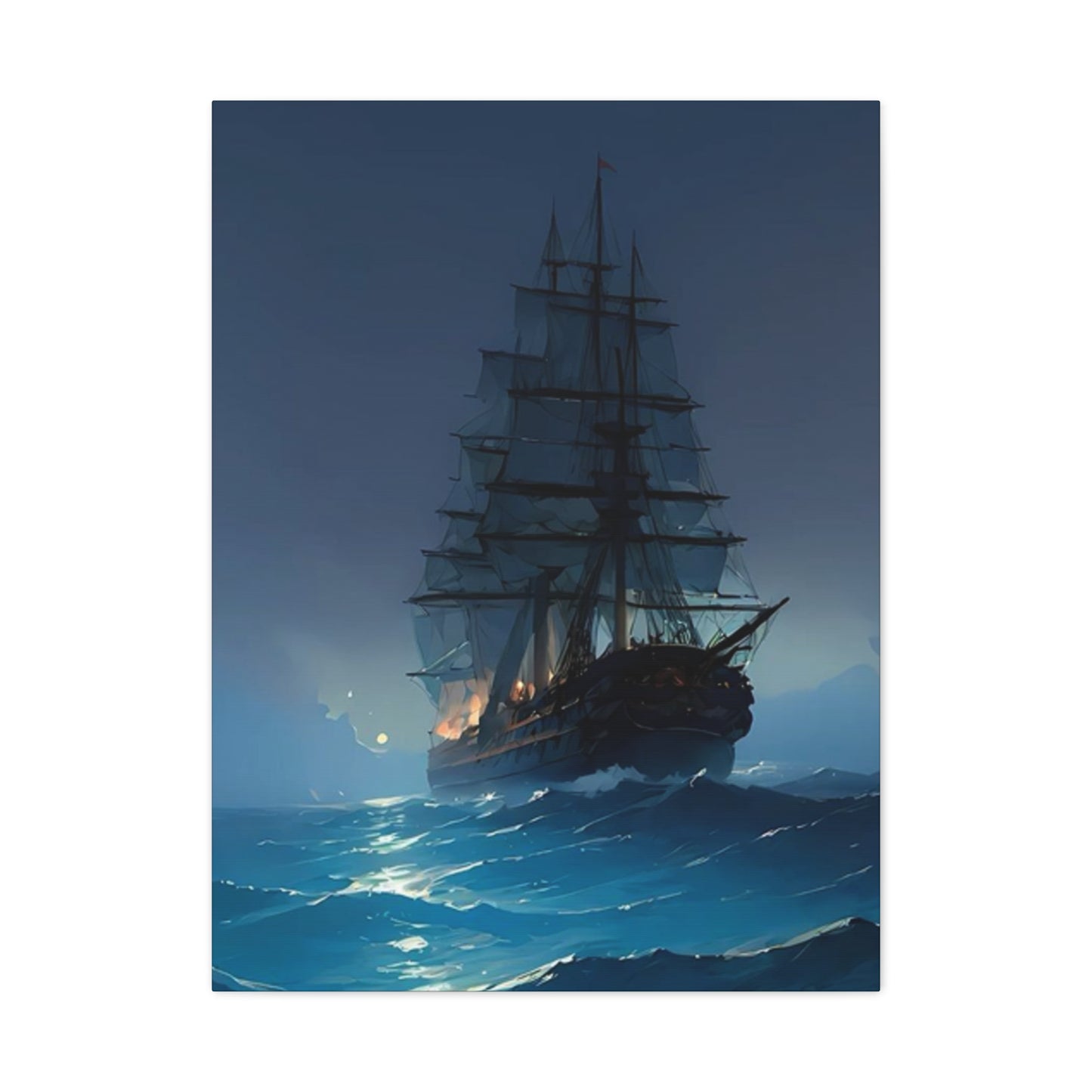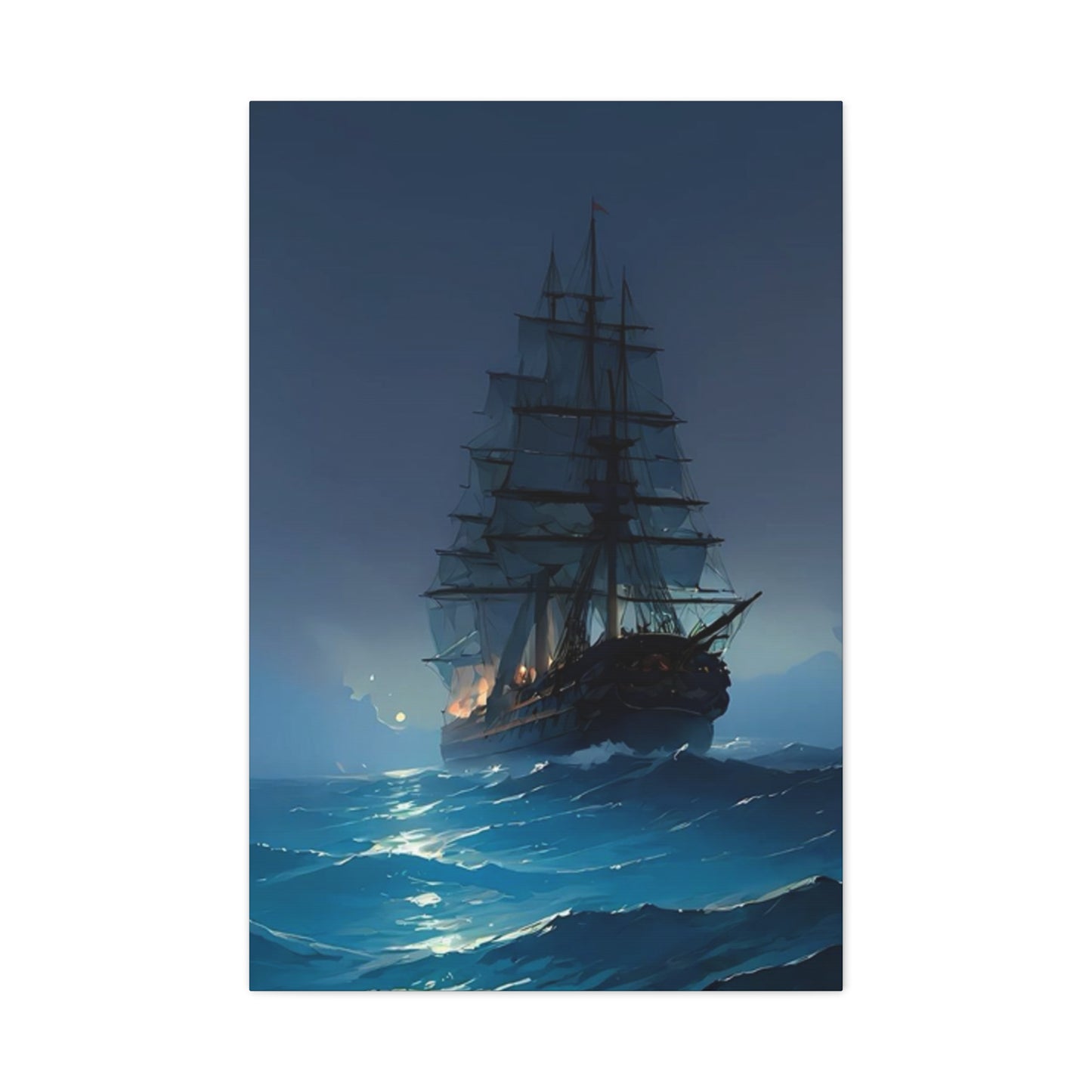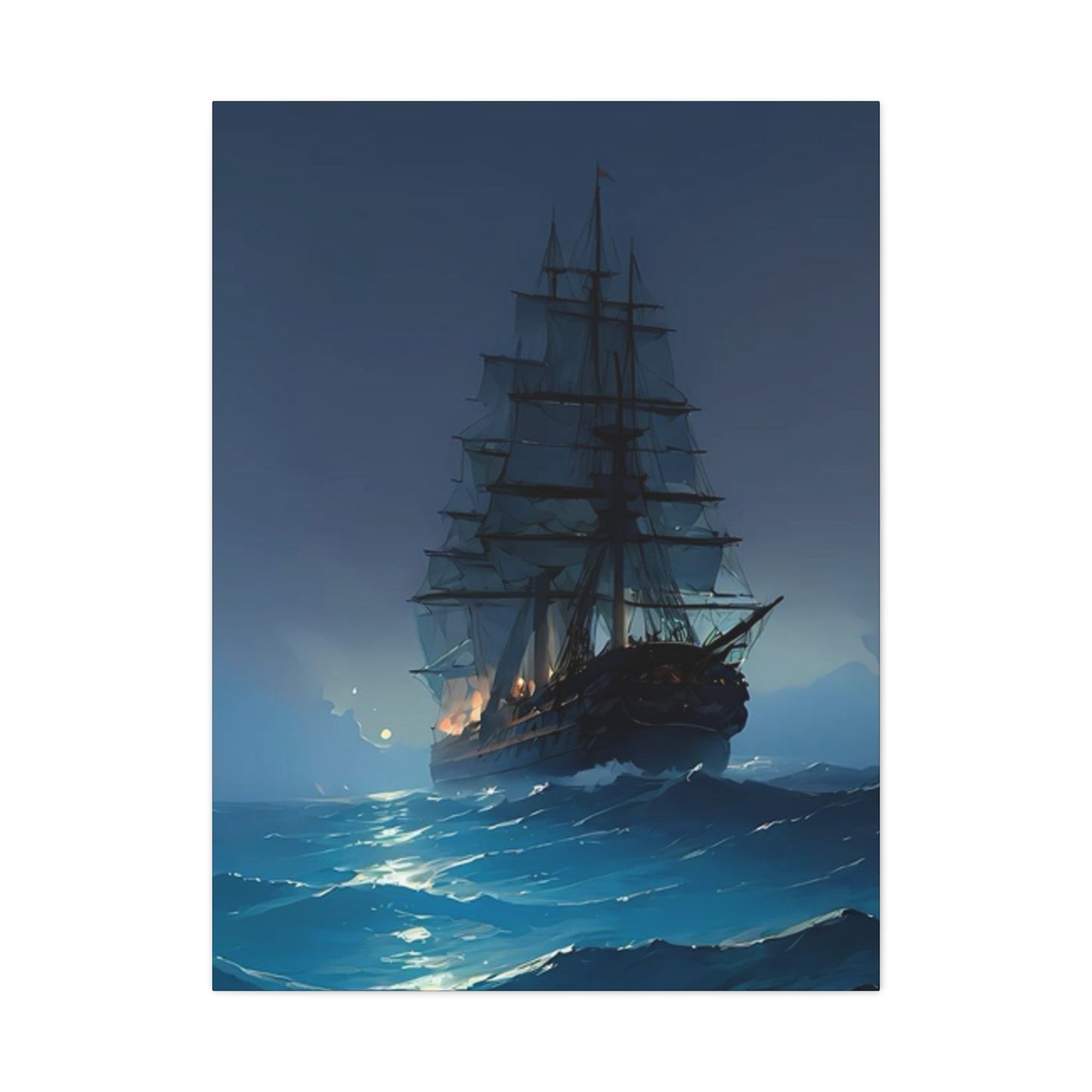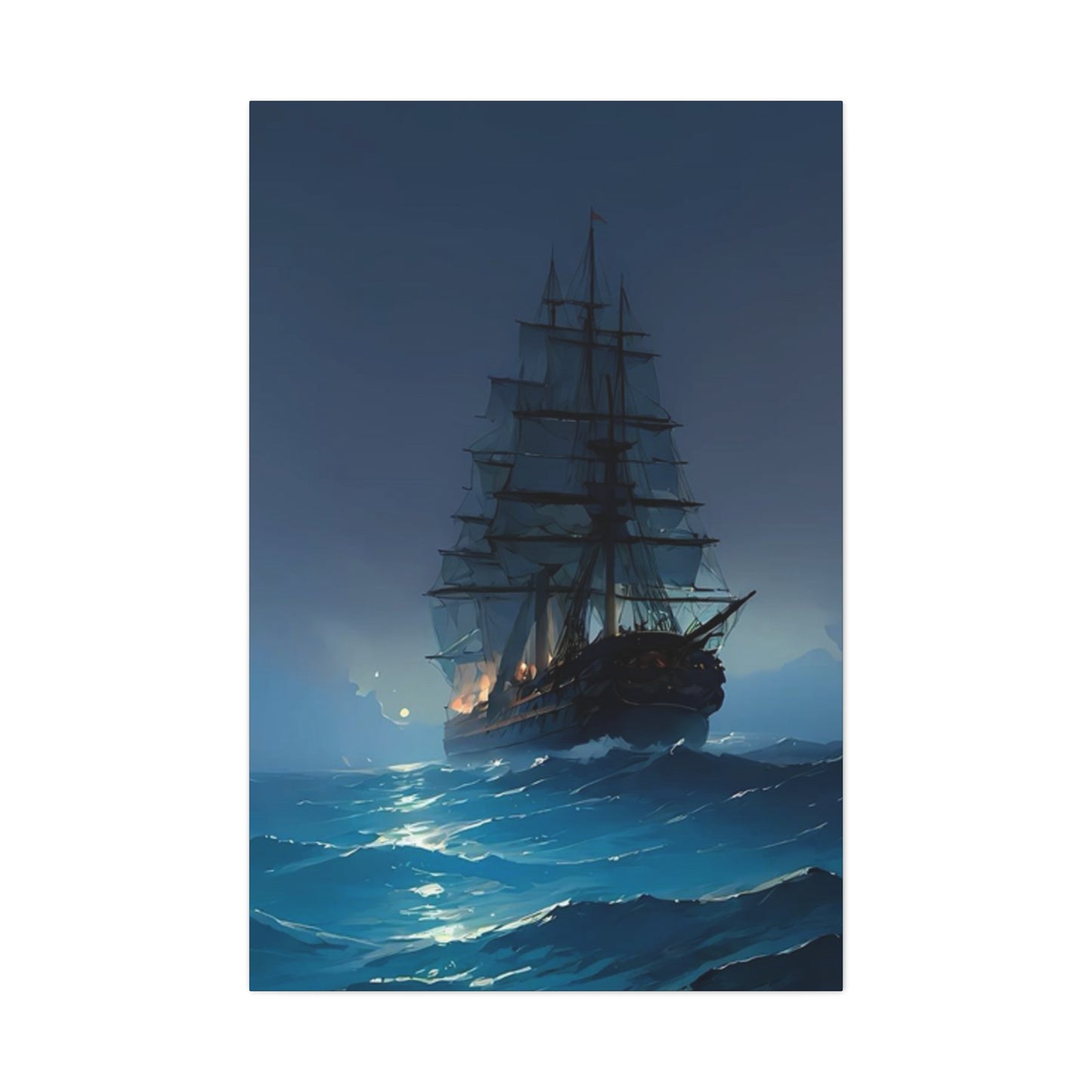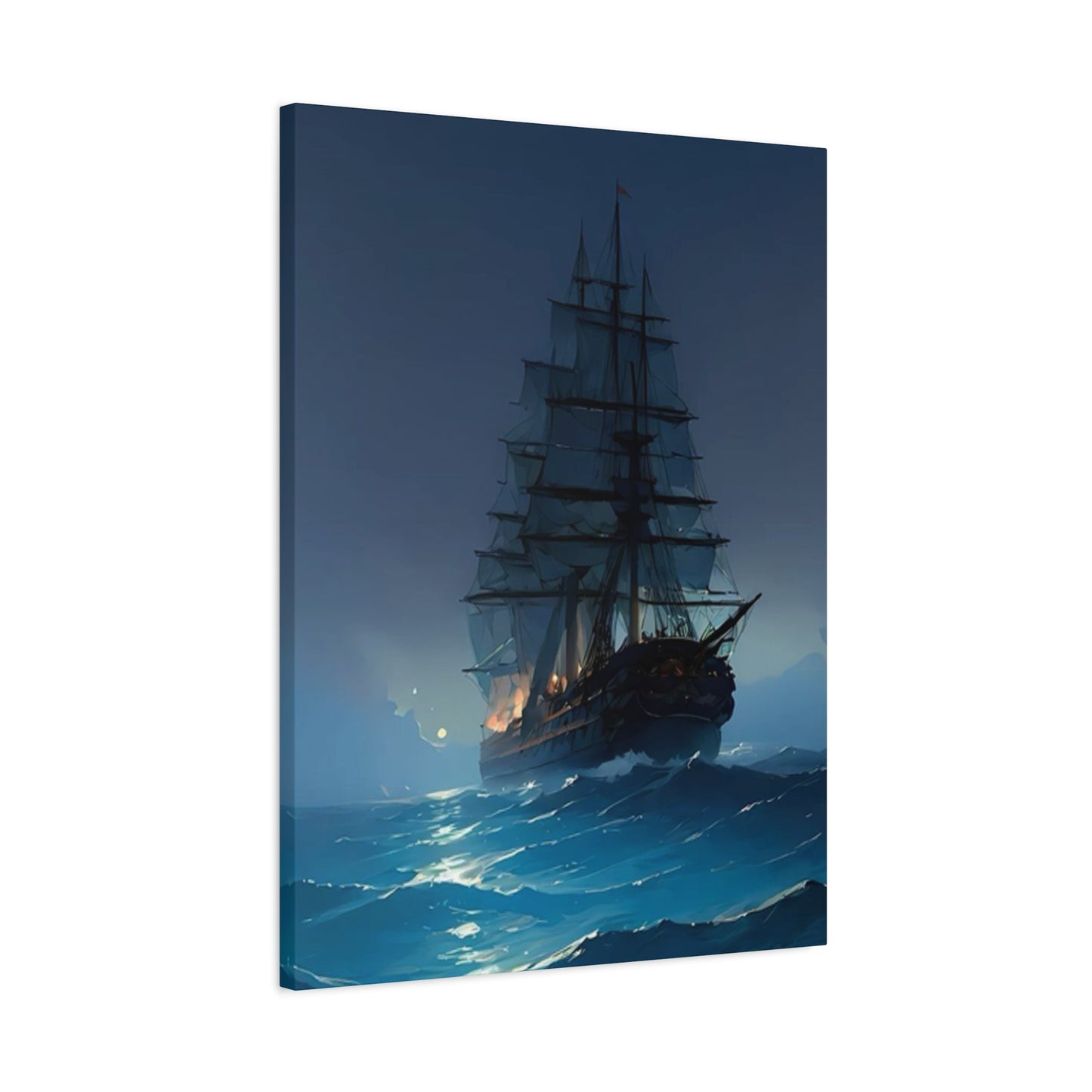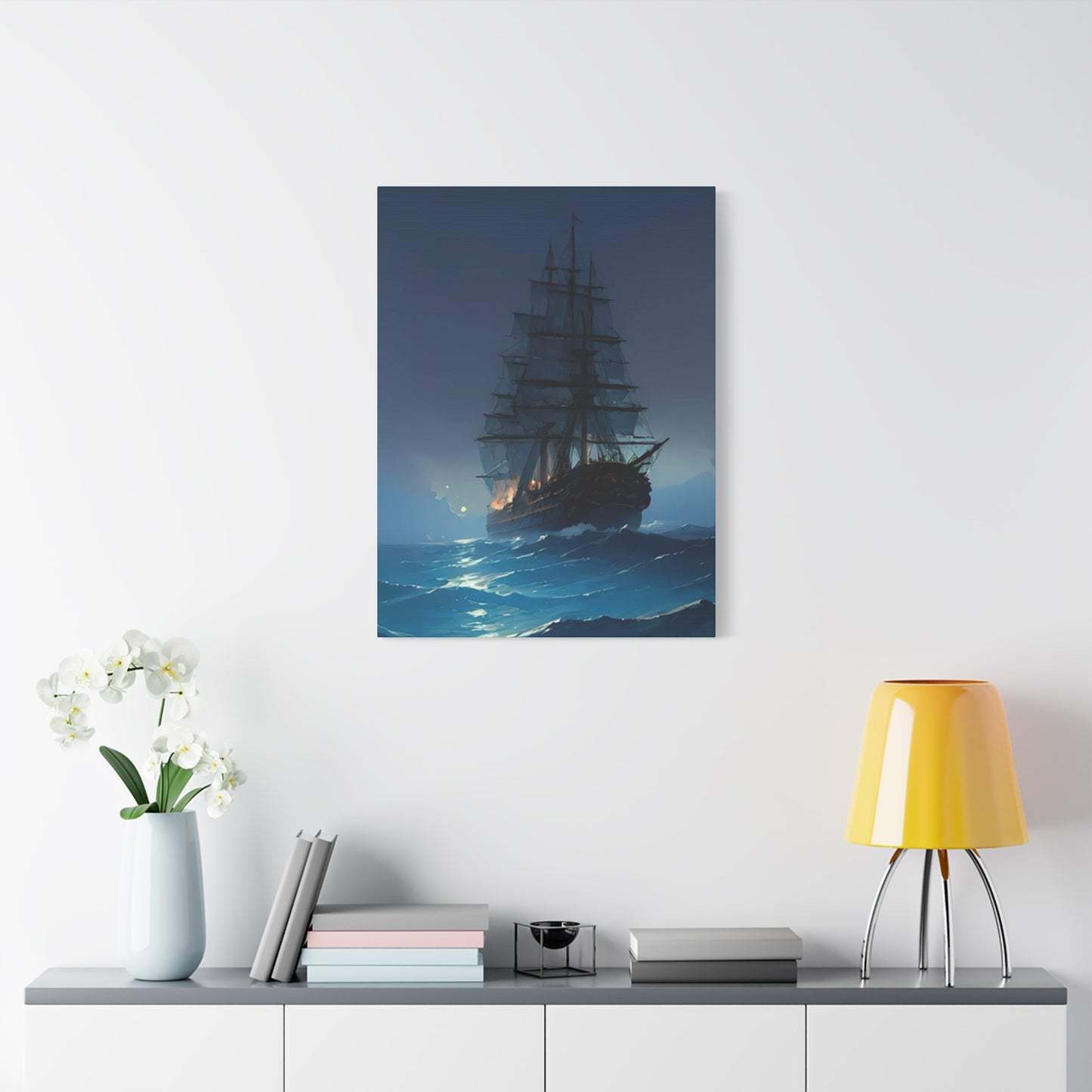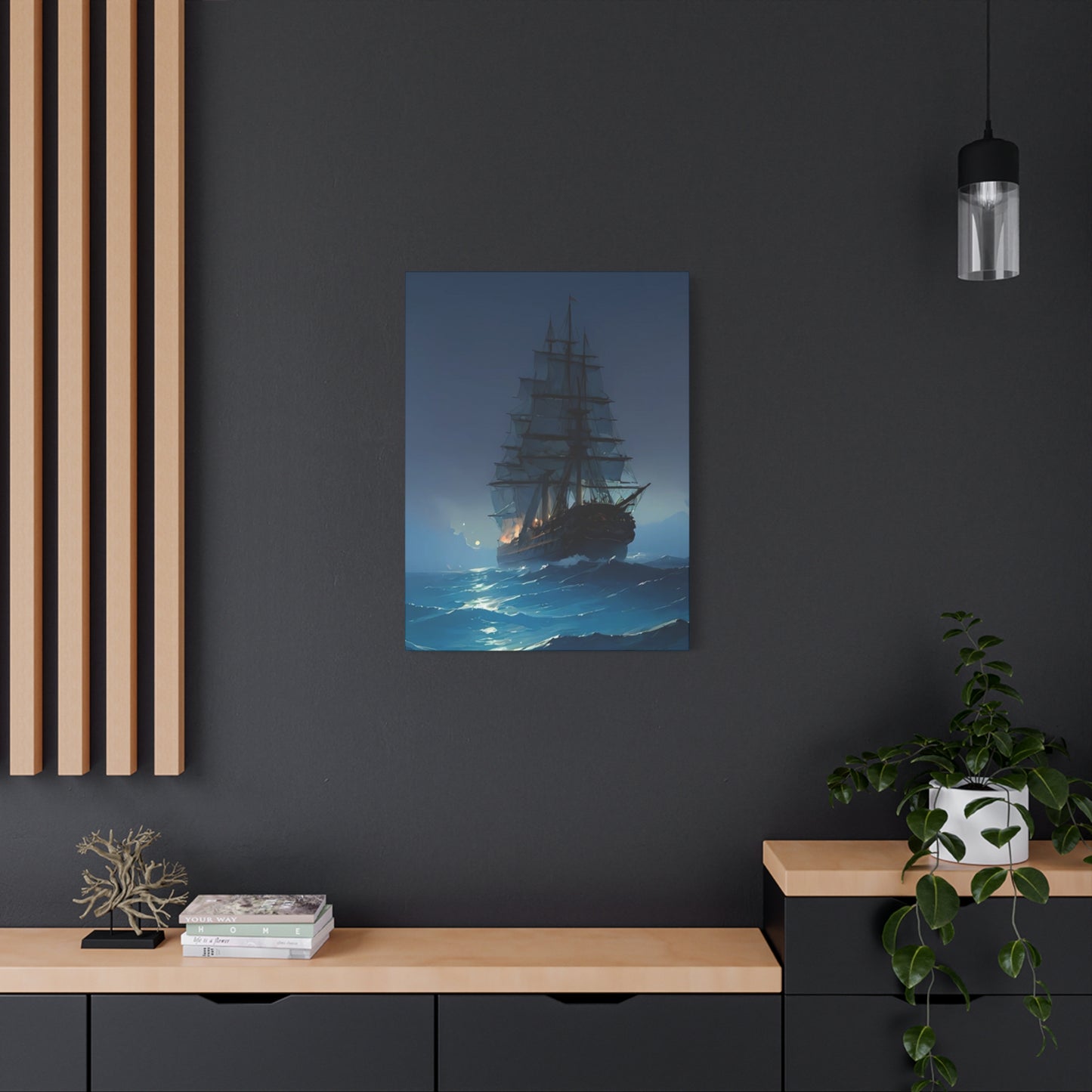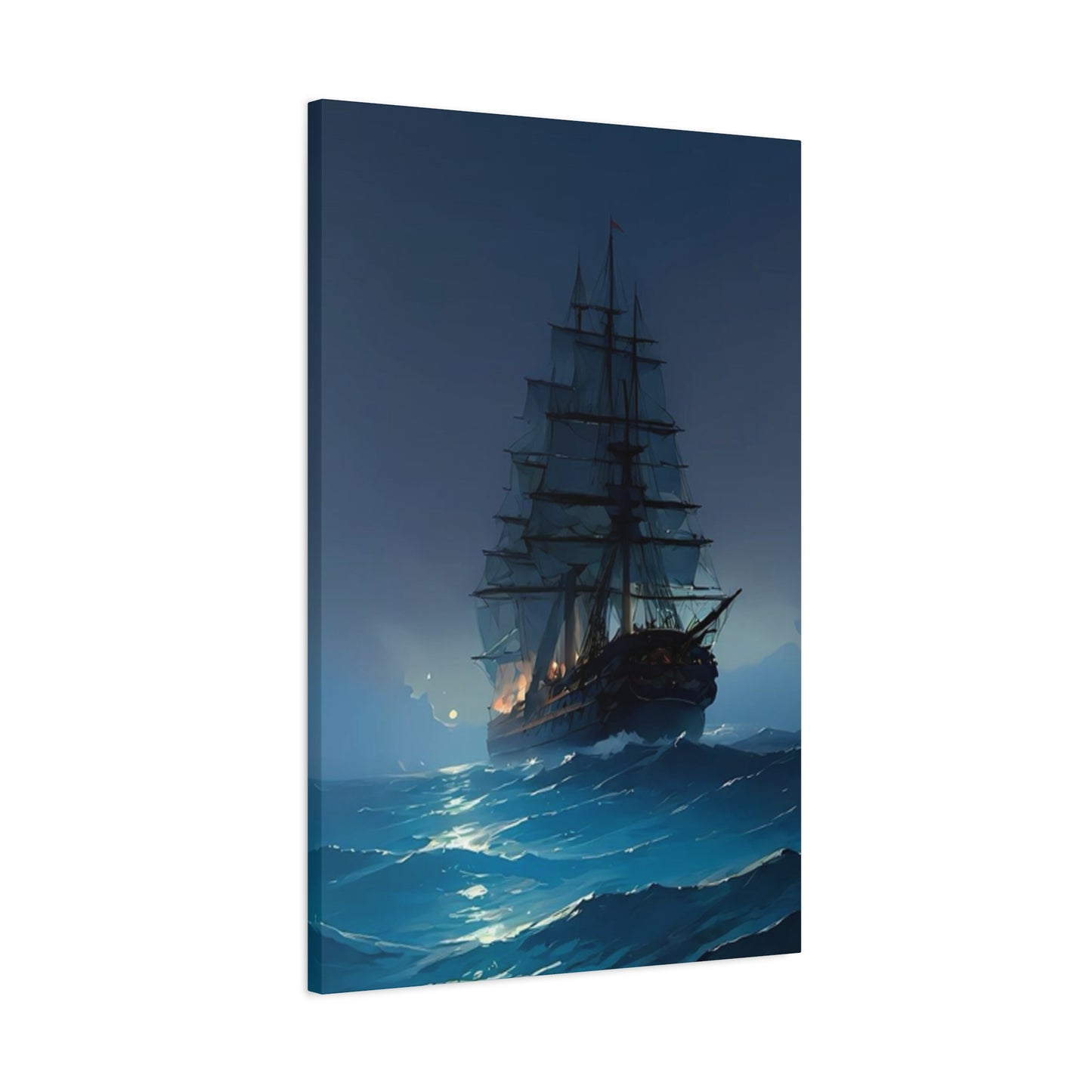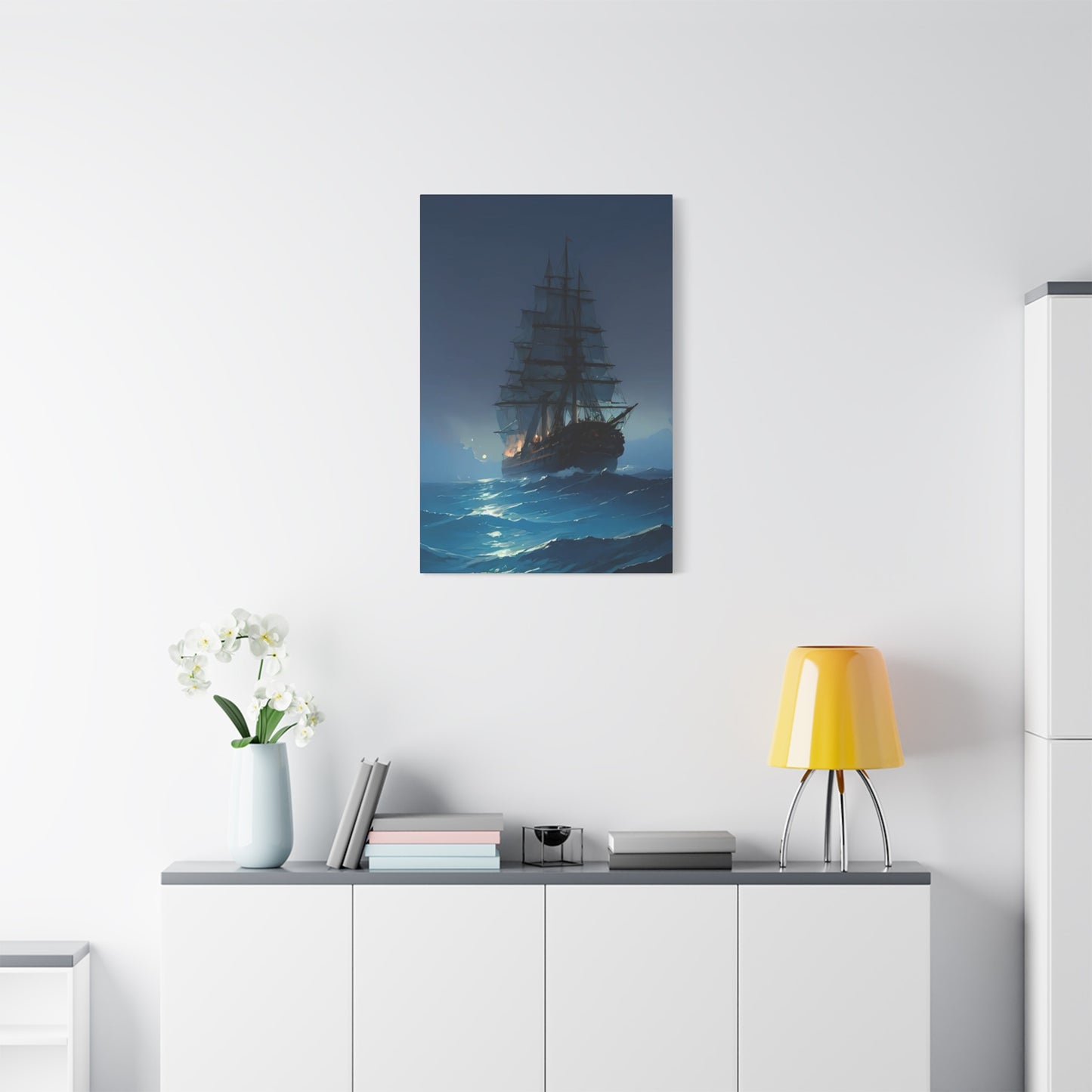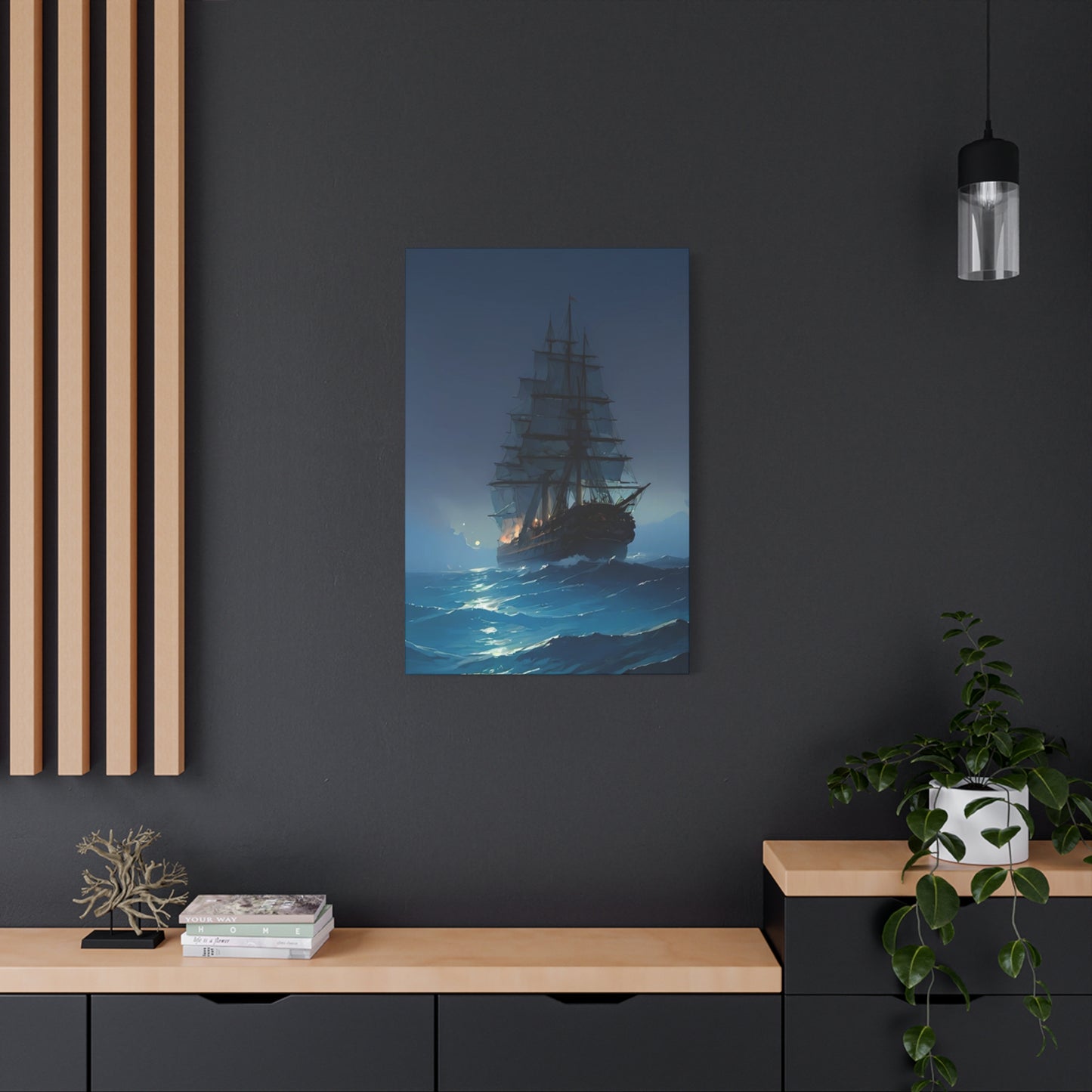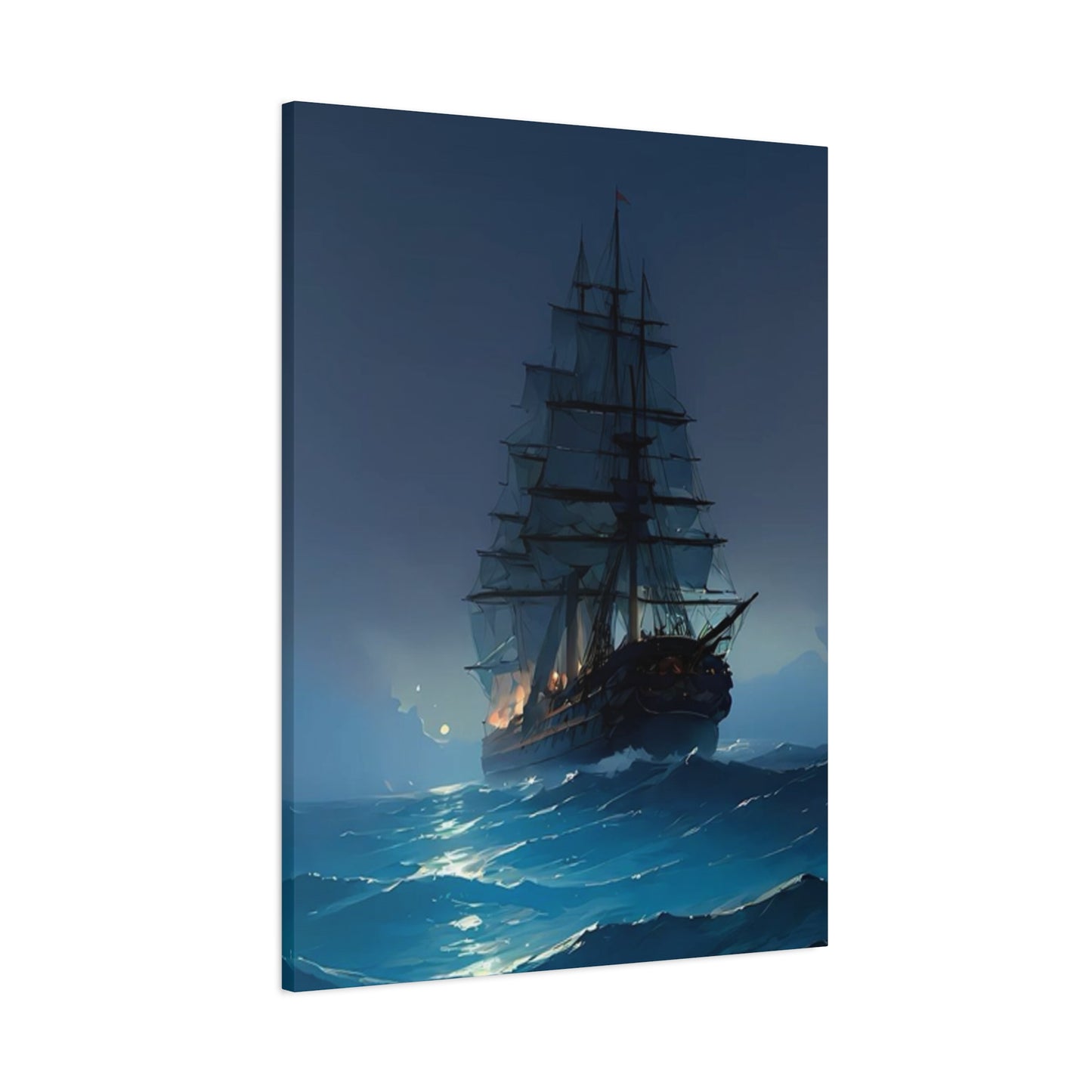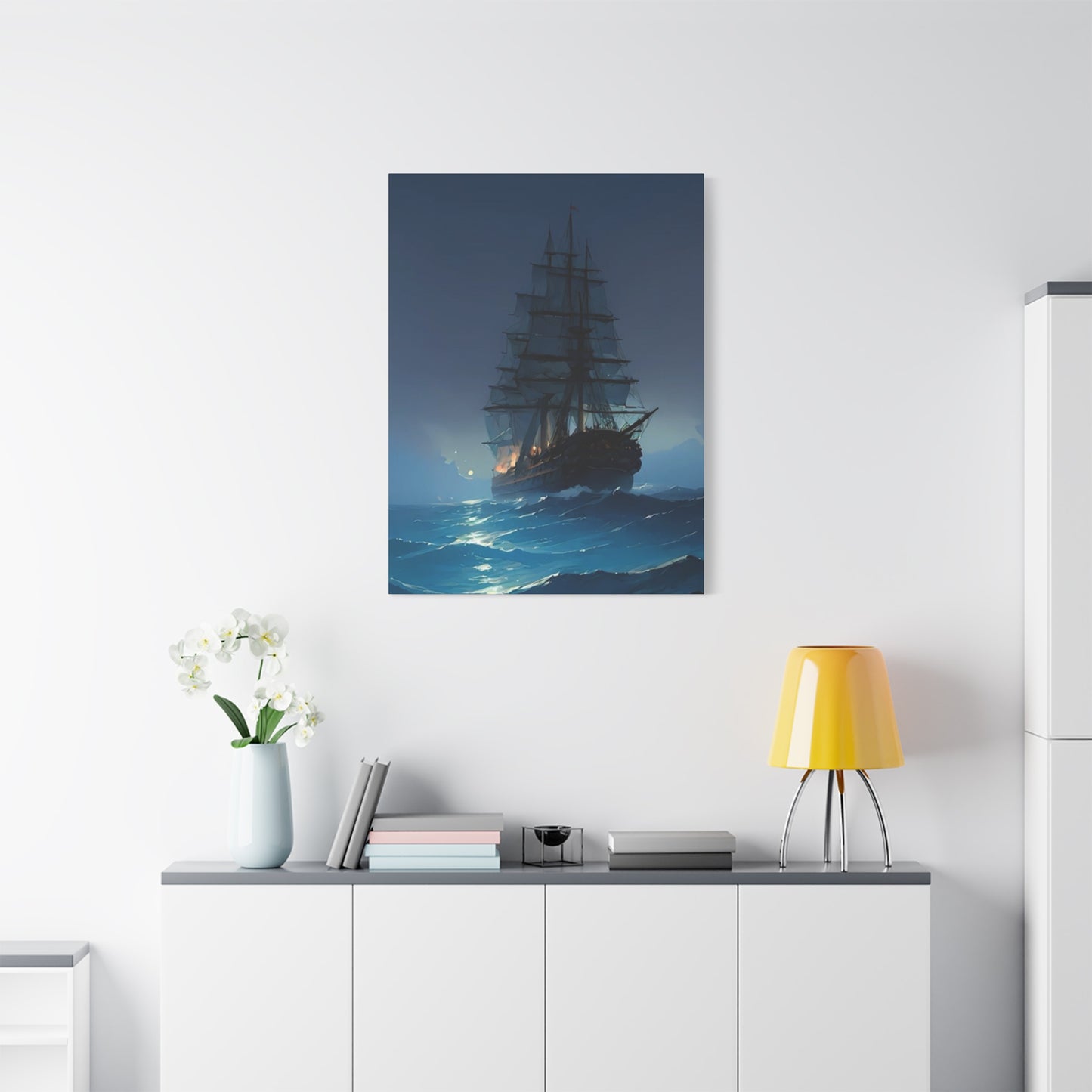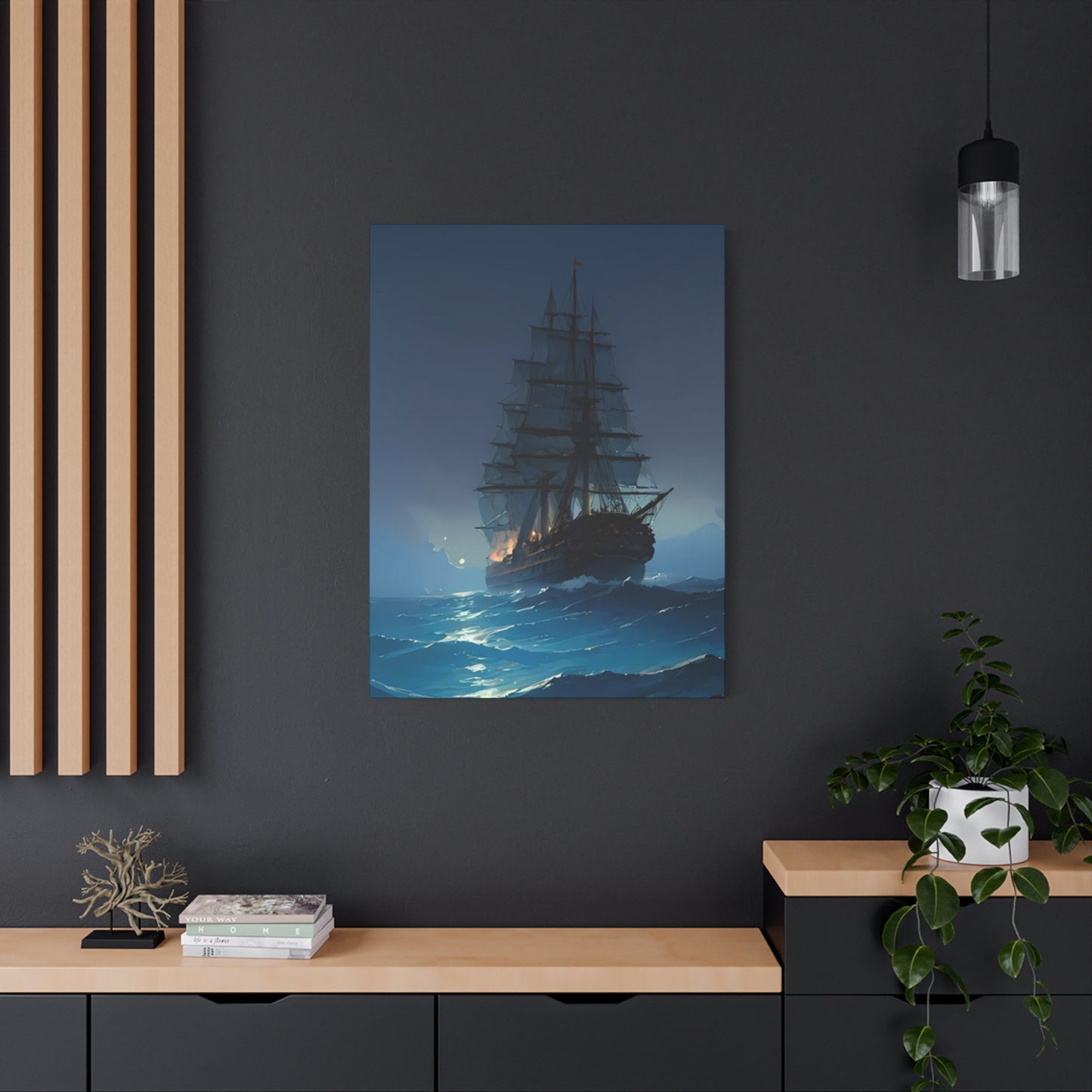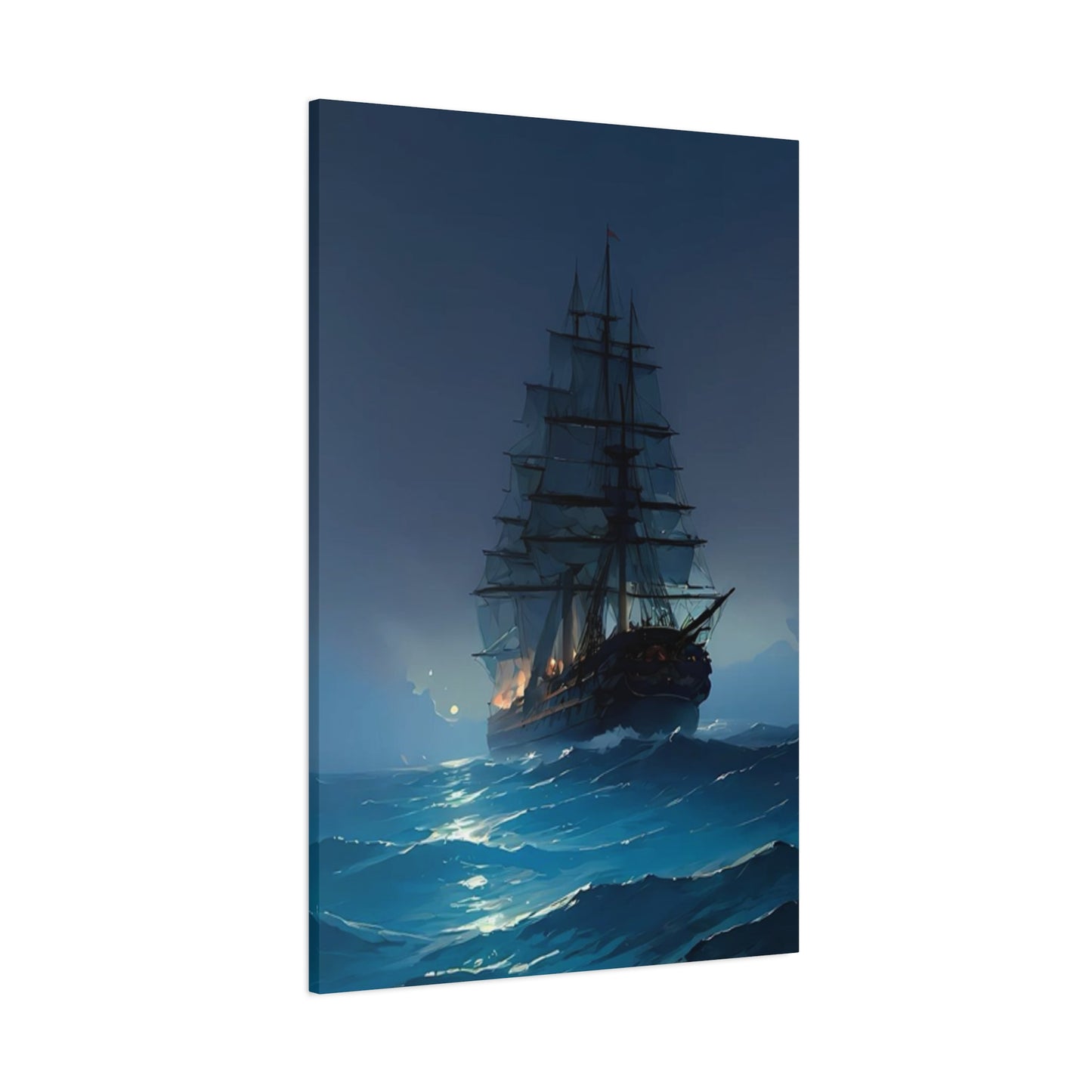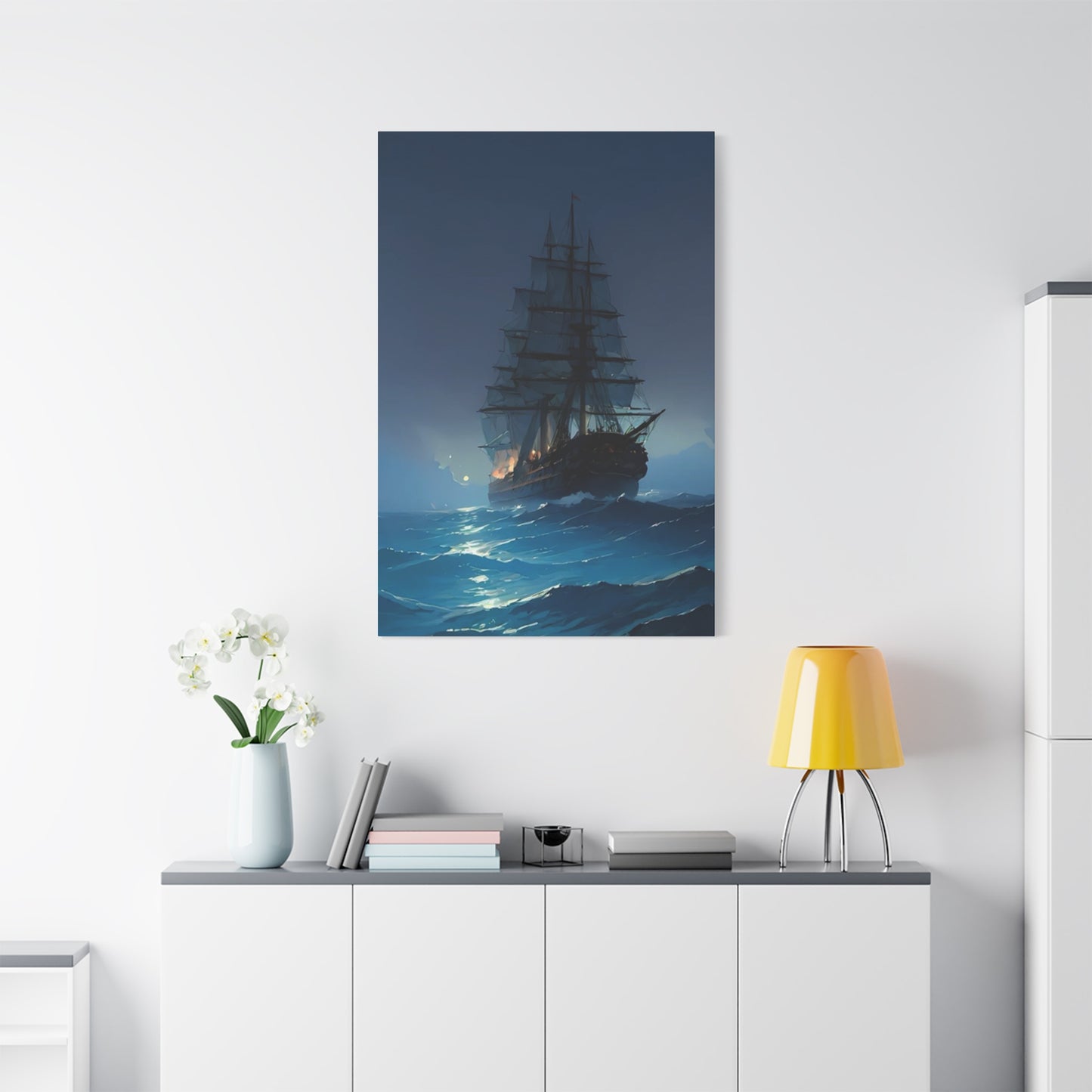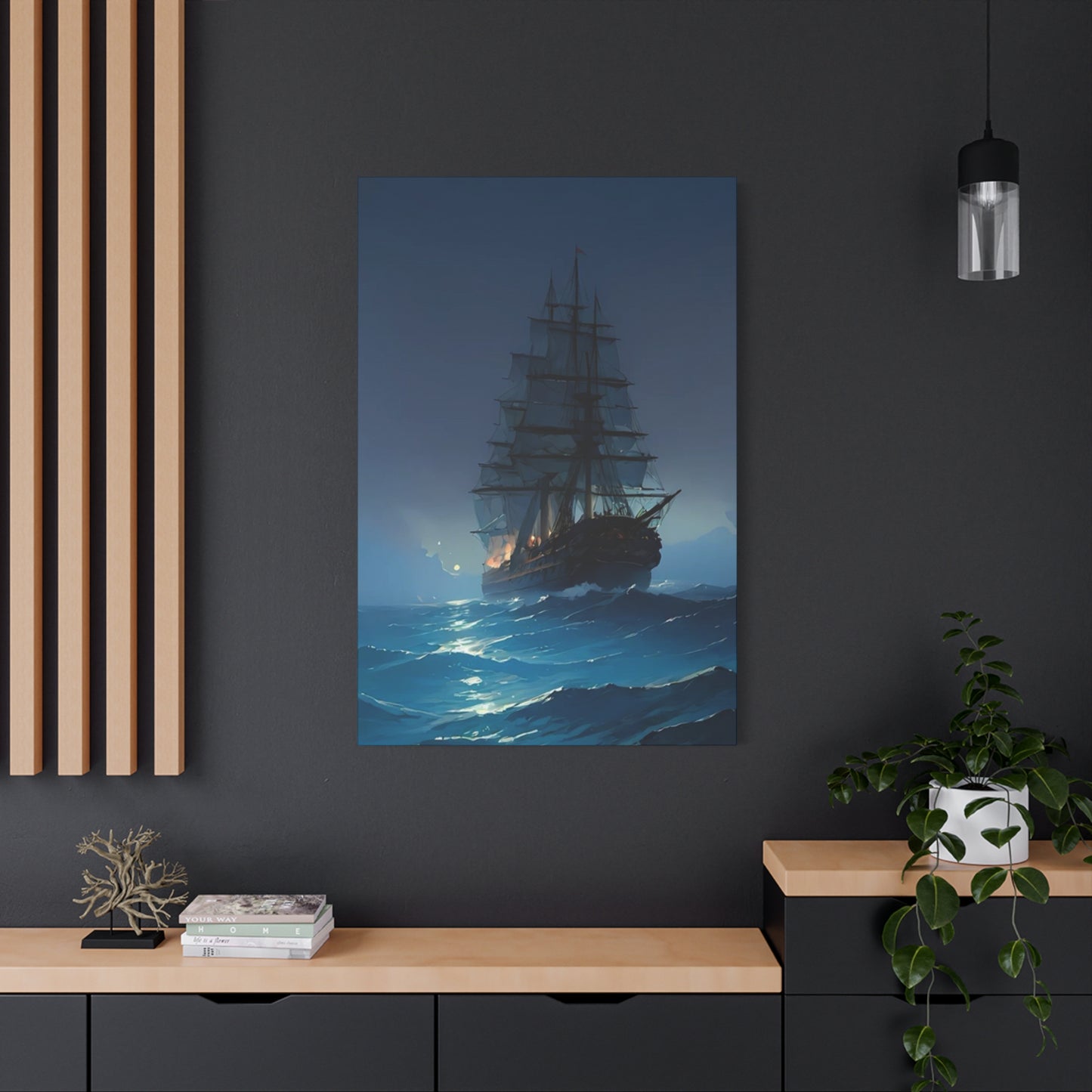Ship at Night Canvas Wall Art: Mystical Ocean Scene
The vast expanses of our world's oceans have long captivated human imagination, serving as the backdrop for countless tales of adventure, mystery, and supernatural encounters. From ancient mariners spinning yarns about spectral vessels to modern sailors reporting unexplained phenomena, the sea remains one of our planet's most enigmatic frontiers. These waters, which cover more than seventy percent of Earth's surface, hold secrets that have inspired generations of storytellers, historians, and those brave enough to venture beyond the safety of harbor walls.
Maritime folklore encompasses a rich tapestry of narratives that blend historical fact with supernatural elements, creating stories that continue to resonate with audiences across cultures and centuries. These tales often feature common themes: vessels that appear and vanish without explanation, crews who sail eternal voyages, and waters that seem to possess a consciousness of their own. Such stories serve not merely as entertainment but as cultural artifacts that reveal humanity's complex relationship with the ocean's power and mystery.
The tradition of nautical storytelling extends far beyond simple ghost stories. These narratives often reflect deeper human concerns about mortality, the unknown, and our place in the natural world. Sailors, who spend months or even years at sea, have always been particularly susceptible to the psychological effects of isolation, weather extremes, and the constant awareness of their vulnerability in the face of nature's fury. In such conditions, the line between reality and imagination becomes blurred, giving birth to legends that persist long after the original witnesses have passed away.
Modern maritime archaeology and oceanography have revealed that our oceans contain millions of shipwrecks, each with its own story of triumph or tragedy. These underwater graveyards serve as tangible reminders of the countless souls who have ventured onto the waves, some never to return. The discovery of famous wrecks like the Titanic has only reinforced our fascination with maritime disasters and the stories they generate.
The psychological impact of the ocean on human consciousness cannot be understated. The sea's ever-changing moods, from placid calm to violent storm, mirror the complexities of human emotion. This natural parallel has made maritime settings ideal for exploring themes of personal transformation, spiritual journey, and the confrontation with forces beyond human control. Writers and storytellers have long recognized the ocean's metaphorical power, using it to represent everything from the subconscious mind to the boundary between life and death.
Cultural variations in maritime folklore reveal how different societies have interpreted their relationship with the sea. Coastal communities often develop unique traditions and beliefs centered around ocean phenomena, while island cultures may view the sea as both protector and potential destroyer. These regional differences add richness to the global collection of maritime legends, showing how universal themes adapt to local conditions and cultural values.
The role of technology in maritime exploration has paradoxically increased rather than diminished our fascination with oceanic mysteries. Advanced sonar systems and deep-sea submersibles have revealed previously unknown underwater landscapes, complete with bizarre creatures and geological formations that seem almost alien. These discoveries fuel contemporary maritime folklore, proving that even in our technologically advanced age, the ocean retains its capacity to surprise and mystify.
Environmental factors play a crucial role in shaping maritime experiences and the stories that emerge from them. Weather patterns, ocean currents, and astronomical phenomena like moon phases can dramatically affect conditions at sea. These natural variables have historically influenced navigation, fishing, and maritime commerce, while also contributing to the supernatural atmosphere that permeates many oceanic tales.
The social dynamics aboard ships create unique conditions for storytelling and myth-making. Long voyages bring together individuals from diverse backgrounds, each carrying their own cultural traditions and personal experiences. In the confined space of a vessel, these different narrative threads weave together, creating new stories that combine elements from various sources. The hierarchical structure of ship life also influences how stories are told and preserved, with different versions often existing among officers and crew members.
Maritime literature has evolved from ancient epic poems celebrating heroic voyages to contemporary novels exploring psychological and environmental themes. Classic works like Coleridge's "The Rime of the Ancient Mariner" and Melville's "Moby Dick" established many of the archetypal elements found in modern maritime fiction. These foundational texts continue to influence how we conceptualize oceanic adventure and mystery.
The economic importance of maritime trade has always intertwined with the folklore surrounding ocean travel. Merchant vessels carrying valuable cargo attracted not only pirates and privateers but also the attention of storytellers who embellished real events with supernatural elements. Tales of cursed treasure ships and phantom merchants reflect the very real dangers and rewards associated with maritime commerce throughout history.
Religious and spiritual dimensions of maritime folklore reveal humanity's attempt to find meaning in oceanic experiences. Many cultures have developed maritime deities, rituals for safe passage, and beliefs about the spiritual significance of ocean phenomena. These religious elements often merge with practical seamanship knowledge, creating traditions that serve both spiritual and navigational purposes.
The preservation of maritime folklore faces challenges in our modern, increasingly landlocked society. Traditional storytelling practices that once kept these tales alive are being replaced by digital media, potentially altering the nature of how maritime stories are told and remembered. However, new platforms also offer opportunities for sharing these narratives with broader audiences, ensuring their continuation in modified forms.
Sailing Through Shadows
The phenomenon of navigating through periods of uncertainty and darkness represents one of maritime folklore's most compelling themes. Sailors throughout history have reported encounters with mysterious shadows that seem to move independently of any visible source, creating an atmosphere of supernatural dread during already challenging voyages. These experiences often occur during the transition periods of dawn and dusk, when natural lighting conditions create optical illusions that can be interpreted as otherworldly manifestations.
Historical accounts from various maritime cultures describe similar encounters with shadowy presences at sea. Viking sagas mention dark shapes that would follow their longships during extended ocean crossings, while Mediterranean sailors reported seeing moving shadows beneath the water's surface during certain lunar phases. These consistent reports across different cultures and time periods suggest either a shared psychological response to oceanic conditions or the existence of phenomena that science has yet to fully explain.
The psychological basis for shadow encounters at sea involves multiple factors that affect human perception during maritime voyages. Prolonged exposure to the ocean's constant motion can cause disorientation and visual disturbances, while sleep deprivation and stress contribute to altered states of consciousness. The interplay between these psychological factors and the ocean's natural lighting conditions creates an environment where shadows can appear more dynamic and threatening than they would in terrestrial settings.
Meteorological conditions play a significant role in creating shadow phenomena at sea. Fog banks, cloud formations, and atmospheric pressure changes can produce unusual lighting effects that cast moving shadows across the water's surface. These natural occurrences, while scientifically explainable, can appear supernatural to observers who are already in heightened states of alertness due to the inherent dangers of ocean travel.
The symbolic significance of shadows in maritime folklore extends beyond simple visual phenomena to represent deeper themes of mortality and the unknown. Shadows often serve as harbingers of impending danger or as manifestations of guilt and regret carried by individual crew members. This symbolic interpretation transforms mundane sensory experiences into profound psychological and spiritual encounters that resonate with universal human concerns.
Maritime navigation through shadowy conditions requires both technical skill and psychological fortitude. Sailors must rely on instruments and experience rather than visual cues, creating opportunities for mistakes that can have fatal consequences. The stress of navigating in poor visibility conditions contributes to the heightened emotional state that makes supernatural interpretations of ordinary phenomena more likely to occur.
Cultural variations in shadow interpretation reveal how different societies have incorporated these experiences into their maritime traditions. Some cultures view shadows as protective spirits guiding vessels safely through dangerous waters, while others interpret them as malevolent forces seeking to lead ships astray. These cultural differences demonstrate how the same basic phenomena can be understood in radically different ways depending on underlying belief systems.
Modern technology has provided new insights into the nature of shadow phenomena at sea, revealing many previously mysterious occurrences to be the result of natural optical effects. Radar systems and thermal imaging can now detect the actual sources of apparent shadow movements, often revealing marine life or debris that was not visible to the naked eye. However, these technological explanations have not entirely eliminated the emotional impact of shadow encounters for contemporary sailors.
The artistic representation of sailing through shadows has become a powerful metaphor in maritime literature and visual arts. Writers and painters use shadow imagery to convey themes of uncertainty, transformation, and the liminal space between the known and unknown. These artistic interpretations have helped preserve and transmit maritime folklore to audiences who may never experience oceanic travel firsthand.
Training for maritime professionals now includes education about the psychological and perceptual challenges of sailing in low-visibility conditions. This training acknowledges the reality of shadow phenomena while providing practical strategies for maintaining navigational accuracy and crew morale during challenging voyages. The integration of folklore understanding with practical seamanship represents a modern evolution of traditional maritime knowledge.
The continuing relevance of shadow encounters in contemporary maritime experience demonstrates the enduring power of oceanic environments to affect human consciousness. Even with advanced navigation systems and weather prediction technology, sailors still report unusual shadow phenomena that cannot be easily explained by conventional means. These ongoing experiences ensure that tales of sailing through shadows remain a vital part of living maritime tradition.
Personal accounts from modern sailors describe shadow encounters that parallel historical reports, suggesting that certain aspects of oceanic experience transcend technological advancement. These contemporary narratives often emphasize the emotional and psychological impact of shadow encounters rather than focusing solely on their potential supernatural implications, reflecting a more nuanced understanding of the relationship between human perception and maritime environment.
Moonlit Mast
The image of a ship's mast silhouetted against the full moon has become one of the most evocative symbols in maritime folklore, representing the intersection between earthly navigation and celestial guidance. Moonlight has always played a crucial role in nautical activities, providing illumination for nighttime sailing while also creating atmospheric conditions that enhance the mystical aspects of ocean travel. The interplay between lunar phases and maritime activities has generated countless stories about ships that appear and disappear in correlation with the moon's cycles.
Traditional navigation relied heavily on celestial bodies, with the moon serving as both a practical tool for determining position and a source of spiritual guidance for sailors venturing into unknown waters. The lunar calendar influenced departure dates, fishing activities, and other maritime endeavors, creating a deep connection between moon phases and oceanic experiences. This practical relationship evolved into folklore that attributes supernatural properties to vessels that sail under specific lunar conditions.
The physics of moonlight on water creates unique visual effects that have inspired maritime legends across cultures. The moon's reflection creates a silver pathway across the ocean's surface, which sailors have interpreted as everything from a route to the afterlife to a sign of divine favor. The way moonlight illuminates a ship's rigging and sails can transform familiar vessels into ethereal apparitions, contributing to tales of ghost ships that appear only under specific lunar conditions.
Historical records document numerous sightings of mysterious vessels that appear exclusively during full moon periods. These accounts often describe ships with luminous sails and crews that seem to glow with their own internal light. While modern understanding attributes many of these sightings to the effects of bright moonlight on atmospheric moisture and the observer's perception, the consistency of such reports across different cultures suggests that certain atmospheric conditions regularly produce similar visual phenomena.
The romantic and literary associations of moonlit sailing have elevated this imagery beyond mere folklore into the realm of high art and poetry. The combination of moonlight, mast, and ocean creates a visual composition that speaks to fundamental human longings for adventure, romance, and transcendence. This aesthetic power has made moonlit maritime scenes among the most popular subjects in nautical art and literature.
Maritime cultures have developed specific rituals and superstitions related to sailing under different lunar phases. Some traditions consider full moon departures to be particularly auspicious, while others warn against the dangers of sailing during lunar eclipses or new moon periods. These beliefs often incorporate practical considerations about visibility and tidal conditions alongside supernatural concerns about lunar influences on human behavior and natural phenomena.
The psychological effects of moonlight on sailors and passengers create conditions conducive to heightened emotional experiences and altered states of consciousness. The soft, silver illumination can induce meditative states and enhance the tendency toward introspection that naturally accompanies long sea voyages. These psychological factors contribute to the mystical associations that surround moonlit maritime experiences.
Marine wildlife behavior under moonlight adds another dimension to the folklore surrounding moonlit masts. Many sea creatures exhibit different activity patterns during bright nights, with some species becoming more active while others retreat to deeper waters. These behavioral changes can create unusual interactions between vessels and marine life, generating stories about supernatural encounters that coincide with specific lunar conditions.
The technical aspects of nighttime sailing under moonlight present both advantages and challenges for maritime navigation. While moonlight provides natural illumination that can aid in visual navigation and watchkeeping, it can also create misleading shadows and visual distortions that complicate accurate course-keeping. Modern electronic navigation systems have reduced reliance on visual cues, but the fundamental experience of sailing under moonlight remains largely unchanged from historical times.
Contemporary recreational sailing has renewed interest in the aesthetic and spiritual dimensions of moonlit voyaging. Modern sailors often plan trips to coincide with full moon periods, seeking to experience the same sense of wonder and connection with natural cycles that inspired their maritime predecessors. These contemporary experiences help keep alive the emotional and cultural significance of moonlit mast imagery in maritime folklore.
The photographic and cinematographic possibilities of moonlit maritime scenes have created new forms of artistic expression that extend traditional folklore themes. Modern technology allows for the capture and sharing of moonlit sailing images that would have been impossible to record in earlier eras, creating new visual narratives that blend traditional maritime imagery with contemporary aesthetic sensibilities.
Scientific understanding of lunar influences on oceanic conditions has revealed that the moon's gravitational pull affects more than just tidal movements. Subtle changes in wave patterns, current flows, and atmospheric pressure during different lunar phases can influence sailing conditions in ways that support some traditional beliefs about lunar effects on maritime activities, even while debunking supernatural explanations for these phenomena.
The Ghost Ship
Perhaps no maritime legend captures the imagination quite like that of the ghost ship, a vessel doomed to sail the oceans for eternity with its spectral crew. These phantom vessels represent one of the most enduring and widespread themes in nautical folklore, appearing in cultures across the globe with remarkable consistency in their basic characteristics. The archetypal ghost ship typically appears as a vessel from an earlier era, often showing signs of damage or decay, sailing with supernatural speed and displaying an otherworldly luminescence.
The most famous of all ghost ships is undoubtedly the Flying Dutchman, a legendary vessel said to be commanded by Captain Hendrick van der Decken, who was cursed to sail the seas forever after blasphemously vowing to round the Cape of Good Hope even if it took him until Judgment Day. This tale, which originated in Dutch maritime folklore, has been adapted and retold countless times, becoming a central narrative in maritime mythology and inspiring works of literature, opera, and film.
Historical analysis of ghost ship legends reveals that many are based on real vessels that disappeared under mysterious circumstances. The fate of ships lost at sea has always generated speculation and storytelling, particularly when no wreckage or survivors are found to provide closure. The human need to understand and explain these disappearances has led to the creation of supernatural narratives that allow lost vessels to continue existing in a liminal state between life and death.
The psychological phenomenon of pareidolia, where the human brain interprets random or vague stimuli as familiar objects, plays a significant role in ghost ship sightings. At sea, where the horizon provides few reference points and atmospheric conditions can create unusual visual effects, distant clouds, fog banks, or even marine debris can be mistaken for phantom vessels. The power of suggestion and maritime folklore primes observers to interpret ambiguous visual stimuli as supernatural manifestations.
Weather phenomena contribute significantly to ghost ship sightings, with certain atmospheric conditions creating optical illusions that can make ordinary vessels appear spectral or cause them to seem to vanish and reappear mysteriously. The Fata Morgana mirage effect, caused by temperature inversions over water, can create images of ships floating above the horizon or appearing significantly larger and more ethereal than their actual size and position would suggest.
The social function of ghost ship legends within maritime communities serves multiple purposes beyond entertainment. These stories provide a framework for processing the dangers and uncertainties of sea travel, allowing sailors to confront their fears about death and disappearance through narrative rather than direct experience. Ghost ship tales also serve as cautionary stories, often carrying moral lessons about hubris, greed, or the consequences of violating maritime traditions and superstitions.
Different cultural interpretations of ghost ships reflect varying attitudes toward death, the afterlife, and the relationship between the living and the dead. In some traditions, ghost ships are seen as harbingers of doom, appearing to warn of impending disasters or to collect souls of the dying. Other cultures view phantom vessels as protective spirits, guided by deceased sailors who continue to watch over their living counterparts and assist vessels in distress.
The technological age has not eliminated ghost ship sightings but has instead provided new forms of evidence and interpretation. Radar contacts that appear and disappear without explanation, sonar readings of submerged objects that cannot be relocated, and satellite images showing unexplained vessel-like formations continue to fuel contemporary ghost ship speculation. These modern sightings often involve military personnel or merchant marine officers whose professional credibility lends weight to their reports.
Maritime archaeology has revealed numerous shipwrecks that correspond to legendary ghost ships, providing historical context for supernatural narratives while simultaneously raising new questions about the stories surrounding these vessels. The discovery of shipwrecks often confirms basic historical details found in ghost ship legends while revealing discrepancies in other aspects, suggesting that folklore preserves selective elements of historical truth while embellishing others for dramatic effect.
The environmental impact of modern shipping has created new categories of potential ghost ships in the form of derelict vessels and maritime debris. Abandoned or adrift ships, containers lost overboard, and other debris can create unexpected encounters that modern mariners might interpret through the lens of traditional ghost ship folklore. These contemporary phenomena demonstrate how changing maritime conditions continue to generate new versions of old legends.
Ghost ship legends have evolved to incorporate modern concerns about environmental destruction and maritime disasters. Contemporary versions often feature vessels associated with pollution, nuclear accidents, or climate change, reflecting current anxieties about humanity's impact on marine ecosystems. These updated narratives maintain the traditional structure of ghost ship stories while addressing contemporary fears and moral concerns.
The persistence of ghost ship beliefs in an age of satellite tracking and global positioning systems reveals the enduring human need for mystery and the supernatural. Even when rational explanations are available for maritime phenomena, the emotional and psychological appeal of ghost ship narratives continues to resonate with both seafarers and landlubbers alike, ensuring their continued place in maritime folklore.
Dark Waters, Silent Sails
The concept of dark waters represents some of the most ominous imagery in maritime folklore, describing oceanic regions where unusual phenomena occur and vessels encounter unexplained dangers. These areas, often associated with deep ocean trenches, strong currents, or unusual weather patterns, have gained reputations as places where normal maritime rules seem suspended and supernatural forces hold sway. The combination of dark waters with silent sails creates a particularly haunting image, suggesting vessels moving through these dangerous areas without wind, sound, or any apparent means of propulsion.
Oceanographic research has identified several regions where unusual water conditions create environments that could support dark water legends. Deep ocean areas where different water masses meet can create distinct color variations, underwater currents that flow contrary to surface patterns, and temperature differentials that affect both marine life and atmospheric conditions above the water. These scientific phenomena provide a rational basis for some of the unusual characteristics attributed to dark waters in maritime folklore.
The psychological impact of sailing through visually distinct water masses cannot be understated. Sailors accustomed to the familiar blue-green of normal ocean water may experience unease when encountering the deep indigo or black appearance of extremely deep water, areas where volcanic activity has altered water chemistry, or regions where heavy sedimentation creates unusual coloration. These visual changes can trigger primal fears about the unknown depths below the vessel.
Silent sailing conditions, while rare, do occur naturally when vessels encounter areas of unusual atmospheric pressure or find themselves in the eye of large storm systems. The eerie quiet that accompanies these conditions can be profoundly unsettling to sailors accustomed to the constant sound of wind in the rigging and waves against the hull. When combined with dark water conditions, these silent periods create an otherworldly atmosphere that lends itself to supernatural interpretation.
Historical records document numerous encounters with dark water regions, often described in terms that blend accurate observation with supernatural embellishment. Medieval and Renaissance maritime logs frequently mention areas where the sea appeared black or unusually dark, often accompanied by reports of strange sounds, unusual marine life, or inexplicable changes in wind and current patterns. These historical accounts provide valuable documentation of real oceanic phenomena while illustrating how unusual conditions were interpreted through the lens of contemporary belief systems.
The biological aspects of dark waters often involve areas of high marine productivity where upwelling currents bring nutrients from deep ocean layers to the surface. These regions can support unusual concentrations of marine life, including species that are rarely seen in normal shipping lanes. Encounters with unfamiliar sea creatures in dark water conditions have contributed to legends about monsters and supernatural beings inhabiting these mysterious oceanic regions.
Navigation through dark water areas presents unique challenges that have contributed to their ominous reputation. The unusual optical properties of very dark water can make it difficult to judge depth, identify underwater obstacles, or maintain accurate course references. Traditional navigation techniques that rely on visual cues become less reliable in these conditions, forcing sailors to depend more heavily on instruments and dead reckoning methods.
The literary symbolism of dark waters extends beyond maritime folklore to represent psychological and spiritual states of uncertainty, fear, and transformation. Writers have used dark water imagery to explore themes of depression, moral ambiguity, and the journey into unknown aspects of the human psyche. This symbolic richness has ensured that dark water narratives continue to resonate with audiences who may never experience oceanic travel directly.
Silent sails phenomenon can result from various meteorological conditions, including temperature inversions that prevent normal wind patterns from developing, the center of high-pressure systems where air movement is minimal, and the temporary calm that often precedes major storm systems. Understanding these scientific explanations does not diminish the emotional impact of experiencing silent sailing conditions, particularly when they occur in conjunction with other unusual phenomena.
Contemporary maritime safety protocols now include specific procedures for navigating through areas known for unusual water conditions, including enhanced watchkeeping procedures, additional position fixes, and communication protocols for reporting unusual phenomena. These modern safety measures acknowledge the real navigational challenges presented by dark water conditions while providing rational frameworks for managing the psychological stresses associated with such encounters.
Environmental factors contributing to dark water formation include volcanic activity, underwater landslides, deep-sea mining operations, and large-scale pollution events. Climate change has also created new areas of unusual water conditions as ocean temperatures and current patterns shift, potentially generating new locations where dark water phenomena might occur and contribute to contemporary maritime folklore.
The spiritual and mystical interpretations of dark waters in various cultural traditions reveal how different societies have understood these phenomena. Some cultures view dark waters as sacred spaces where the boundary between the physical and spiritual worlds becomes thin, while others interpret them as dangerous areas to be avoided or traversed only with appropriate ritual protection. These cultural variations demonstrate the universal human tendency to assign meaning to unusual natural phenomena.
Storm Ahead
The approach of a storm at sea represents one of the most dramatic and dangerous situations in maritime experience, generating countless tales of heroism, survival, and supernatural intervention. The phrase "storm ahead" carries weight beyond its literal meteorological meaning, symbolizing impending challenges, tests of character, and the thin line between survival and disaster that defines much of maritime existence. These stories often blend accurate descriptions of severe weather with elements of the supernatural, creating narratives that capture both the physical and psychological intensity of weathering oceanic storms.
Meteorological understanding of storm formation and behavior has advanced significantly, yet the fundamental experience of facing a severe weather system at sea remains largely unchanged from historical times. Modern forecasting provides earlier warnings and more accurate predictions, but vessels still must ultimately confront the raw power of wind and waves once a storm arrives. This continuity of experience helps explain why storm narratives from different eras share similar themes and emotional resonance.
The psychological preparation for storms involves more than practical seamanship skills, encompassing mental and emotional readiness for extended periods of intense stress and danger. Sailors must prepare not only their vessels but also themselves for the disorientation, fatigue, and fear that accompany severe weather conditions. The folklore surrounding storm encounters often emphasizes the importance of maintaining morale and cohesion among crew members during these challenging periods.
Historical storm accounts reveal patterns in how maritime cultures have interpreted severe weather events. Many traditions include stories of supernatural beings associated with storms, from sea gods and goddesses to demonic entities that ride the wind and waves. These mythological frameworks provided sailors with ways to understand and psychologically cope with forces that were beyond human control or scientific explanation at the time.
The physical effects of severe storms on vessels create conditions that can easily be interpreted as supernatural phenomena. Extreme wind pressures can cause unusual sounds, structural creaking that resembles voices, and vibrations that feel like the presence of other entities aboard the ship. Combined with the stress and sleep deprivation common during storm periods, these physical effects can generate experiences that seem to confirm supernatural beliefs about storm encounters.
Different types of storms create distinct challenges and folklore traditions. Hurricanes and typhoons generate stories about spiral winds that can trap vessels in endless circles, while nor'easters and winter storms feature narratives about ice, cold, and the supernatural beings that inhabit frozen seascapes. Each storm type contributes its own characteristics to the broader folklore of tempestuous weather at sea.
The technology of storm prediction and tracking has created new forms of storm-related maritime folklore. Satellite weather imagery, computer modeling, and global communication systems provide unprecedented information about approaching weather systems, yet contemporary sailors still report encounters with unexpected storm cells, rapidly changing conditions, and weather phenomena that seem to defy forecasting models. These modern experiences demonstrate that technological advancement has not eliminated the element of surprise and danger in maritime weather encounters.
Survival techniques for severe weather have evolved from traditional seamanship practices to include modern safety equipment and communication systems, but the fundamental principles of storm survival remain rooted in time-tested maritime wisdom. The folklore surrounding storm survival often emphasizes the importance of preparation, teamwork, and maintaining hope during the darkest hours of a weather event.
The environmental impact of climate change has altered storm patterns and intensities, creating new challenges for modern mariners and potentially generating new forms of storm folklore. Unprecedented weather events, changing seasonal patterns, and unusual storm behaviors contribute to contemporary maritime narratives that blend traditional storm themes with modern environmental concerns.
Religious and spiritual aspects of storm encounters appear consistently across maritime cultures, with many traditions including prayers, rituals, and superstitions specific to severe weather situations. These spiritual practices serve both psychological and social functions, providing comfort and maintaining group cohesion during periods of extreme stress and danger.
The aftermath of storms generates its own folklore traditions, including stories about miraculous survivals, vessels found in impossible locations, and encounters with supernatural beings during the calm periods that follow severe weather. These post-storm narratives often emphasize themes of rebirth, transformation, and gratitude for survival, reflecting the profound impact that severe weather experiences have on human consciousness.
Storm photography and documentation in the modern era have created new visual records of severe weather at sea, yet these technological capabilities cannot fully capture the experiential reality of living through a maritime storm. The gap between recorded documentation and lived experience continues to provide space for folklore and personal narrative to supplement objective meteorological data with emotional and psychological truth.
Night Tide Journey
The experience of sailing during nocturnal tidal periods represents a unique intersection of natural forces, navigational challenges, and atmospheric conditions that has generated distinctive maritime folklore. Night tides often produce unusual water movements, sounds, and visual effects that can create mysterious and sometimes supernatural experiences for those venturing onto dark waters. The combination of tidal forces with limited visibility creates an environment where normal maritime reference points become unreliable and sailors must depend more heavily on their other senses and intuitive understanding of oceanic conditions.
Tidal mechanics operate according to predictable gravitational forces, yet the experiential reality of navigating during strong tidal flows in darkness can feel anything but predictable. The sound of water rushing past a vessel's hull, the sensation of being pushed or pulled by invisible forces, and the way familiar landmarks disappear and reappear in unexpected positions all contribute to the otherworldly atmosphere that surrounds night tide journeys.
Historical navigation during tidal periods required intimate knowledge of local water conditions, including the timing of high and low tides, the direction and strength of tidal currents, and the way these forces interacted with wind patterns and weather conditions. This traditional knowledge was often passed down through oral tradition, creating a body of maritime lore that blended practical seamanship with supernatural beliefs about the forces that controlled tidal movements.
The biological aspects of night tidal periods involve marine life behaviors that can create unusual encounters for sailors. Many sea creatures are most active during tidal changes, and nocturnal species may become more visible or audible during strong tidal flows. Bioluminescent organisms can create spectacular light displays in disturbed water, leading to sightings that have been interpreted as supernatural phenomena by observers unfamiliar with marine biology.
Different coastal regions produce distinctive tidal patterns that have generated localized folklore traditions. Areas with extreme tidal ranges, such as the Bay of Fundy or the Severn Estuary, have developed specific stories about tidal phenomena, while regions with more moderate tides focus on other aspects of night sailing. These regional variations demonstrate how local environmental conditions shape maritime folklore while maintaining common themes about the relationship between human travelers and natural forces.
The psychological effects of night tide sailing include sensory disorientation caused by the combination of darkness and water movement, which can affect balance, spatial awareness, and judgment. The constant sound of moving water can mask other audio cues that sailors normally use for navigation and safety, while the tactile sensation of tidal flow creates a feeling of being controlled by forces beyond human agency.
Modern tidal prediction and navigation technology has provided scientific explanations for tidal phenomena while simultaneously revealing new complexities in tidal behavior that earlier mariners could not have understood. Computer models now predict tidal movements with remarkable accuracy, yet local conditions, weather influences, and unusual oceanographic events can still create tidal situations that defy prediction and challenge even experienced navigators.
The artistic representation of night tide journeys in maritime literature and visual arts often emphasizes the liminal quality of these experiences, portraying them as threshold moments where characters confront fundamental questions about their relationship with natural forces. The imagery of moving through darkness propelled by invisible currents serves as a powerful metaphor for life transitions and spiritual journeys.
Environmental changes affecting tidal patterns have created new conditions that contemporary sailors must navigate while drawing on traditional tidal knowledge. Sea level rise, altered river flows, and changing coastal geography all influence tidal behavior in ways that can make historical tidal information less reliable, requiring modern mariners to adapt traditional practices to changing conditions.
The social aspects of night tide sailing often involve increased cooperation and communication among crew members, as the challenging conditions require heightened attention and coordination. The folklore surrounding these experiences frequently emphasizes the importance of trust, teamwork, and shared vigilance during periods when normal navigational cues are limited or unavailable.
Safety considerations for night tide navigation have evolved to include modern communication and positioning systems while maintaining traditional practices such as posted watches, sound signals, and visual references. The integration of new technology with time-tested seamanship principles reflects the continuing relevance of traditional maritime knowledge even in contemporary sailing contexts.
Cultural interpretations of tidal forces vary significantly among different maritime societies, with some viewing tides as manifestations of divine will, others seeing them as natural cycles to be respected and understood, and still others incorporating tidal rhythms into spiritual and ceremonial practices. These cultural differences demonstrate how the same natural phenomena can be understood and integrated into human experience in multiple ways.
Sails in the Starlight
The image of sails illuminated by starlight represents one of the most romantic and mystical aspects of maritime experience, combining the practical necessity of nighttime sailing with the aesthetic beauty of celestial navigation. Throughout maritime history, stars have served as both navigational tools and sources of inspiration, creating a unique relationship between sailors and the night sky that has generated countless stories, songs, and legends about vessels that sail by starlight alone.
Stellar navigation techniques developed by ancient mariners created the foundation for oceanic exploration and trade, with different cultures developing sophisticated methods for using star positions to determine location and course. These practical skills were often surrounded by mythology and folklore that attributed supernatural properties to certain stars and constellations, creating navigation systems that combined empirical observation with spiritual belief.
The physics of starlight on sail material creates visual effects that have inspired maritime folklore across cultures. Canvas and modern sail materials reflect and diffuse starlight in ways that can make sails appear luminous or ghostly, particularly when viewed from a distance or under specific atmospheric conditions. These optical effects have contributed to stories about phantom vessels that appear only under starry skies and disappear when clouds obscure the celestial display.
Astronomical phenomena such as meteor showers, planetary alignments, and unusual stellar formations create special conditions for starlight sailing that have generated their own folklore traditions. Sailors have long associated certain celestial events with changes in weather, ocean conditions, or supernatural activity, creating calendars of maritime superstition that coordinate earthly activities with celestial cycles.
The psychological impact of sailing under starlight involves a complex interplay between the practical demands of night navigation and the emotional response to one of nature's most spectacular displays. The combination of responsibility for vessel safety with the aesthetic experience of the night sky can create heightened states of awareness and emotional sensitivity that contribute to the mystical associations surrounding starlight sailing.
Different latitude regions provide varying starlight experiences that have influenced regional maritime folklore. Equatorial sailors have access to stars from both hemispheres, polar mariners must contend with extreme seasonal variations in daylight and starlight, and temperate zone sailors experience moderate seasonal changes that affect their celestial navigation options. These geographical differences have created distinct traditions of starlight folklore adapted to local conditions.
Modern light pollution has significantly altered the starlight sailing experience, with contemporary mariners often unable to see the full celestial display that was available to their historical counterparts. This environmental change has made starlight sailing experiences increasingly rare and precious, contributing to their romantic and mystical associations while also creating new appreciation for dark sky conditions.
The biological aspects of night sailing include adaptations in human vision and circadian rhythms that affect how sailors perceive and interact with starlight conditions. Night vision capabilities, the adjustment period required for optimal star visibility, and the effects of artificial lighting on astronomical observation all influence the practical and aesthetic dimensions of starlight sailing.
Cultural variations in star mythology have created different frameworks for interpreting starlight sailing experiences. Some traditions view certain stars as protective spirits for mariners, while others associate stellar phenomena with warnings or omens. These cultural differences demonstrate how universal human experiences with celestial beauty can be understood through diverse mythological and spiritual systems.
The technical aspects of sail handling under starlight conditions require specialized skills and equipment that have evolved over centuries of maritime development. Traditional techniques for adjusting sails by feel and sound remain relevant even with modern instrumentation, and the folklore surrounding these skills often emphasizes the intuitive connection between experienced sailors and their vessels.
Contemporary recreational sailing has renewed interest in starlight navigation and the aesthetic experiences it provides. Modern sailors often plan trips to coincide with optimal starlight conditions, seeking to recreate historical experiences while using current safety technology to minimize risks. This modern revival of starlight sailing helps maintain traditional maritime skills while creating new opportunities for celestial appreciation.
Environmental factors affecting starlight visibility include atmospheric conditions, weather patterns, and seasonal variations that can dramatically alter the night sky display available to sailors. Understanding these natural variables helps explain historical patterns in maritime folklore while providing contemporary sailors with knowledge needed to optimize their own starlight sailing experiences.
Black Ship, Moon Sky
The dramatic contrast between a dark vessel silhouetted against the moonlit sky creates one of maritime folklore's most powerful visual metaphors, representing the intersection between human technology and natural forces. Black ships in maritime tradition often carry connotations of mystery, death, or supernatural origin, while the moon sky provides a backdrop that can make even ordinary vessels appear otherworldly and threatening. This imagery has inspired countless stories about phantom vessels that appear only under specific lunar conditions.
Conclusion:
Ship at Night canvas wall art captures the enigmatic beauty and tranquil mystery of the ocean under moonlit skies, offering a captivating way to elevate interior spaces. By depicting a lone ship gliding across dark waters, illuminated subtly by moonlight or distant stars, this artwork evokes a sense of adventure, solitude, and reflection. Perfect for living rooms, bedrooms, offices, or study areas, it transforms walls into portals of imagination and introspection, immersing viewers in a serene maritime narrative.
The appeal of Ship at Night canvas art lies in its combination of realism, atmosphere, and emotional resonance. The painting balances dramatic contrasts between dark ocean depths and luminous night skies, emphasizing both the vastness of the sea and the quiet solitude of the vessel. This interplay of light and shadow not only creates visual depth but also invites contemplation, making the piece ideal for spaces designed to inspire calm, thoughtfulness, or creative reflection.
From a design perspective, this ocean-themed wall art is highly versatile. Large-scale canvases serve as commanding focal points, anchoring living rooms or creative studios with a sense of grandeur and drama. Smaller prints can complement gallery walls, paired with nautical, abstract, or nature-inspired artworks to create layered visual interest. The palette of deep blues, subtle grays, and hints of luminous highlights integrates seamlessly with a wide variety of interior styles, including coastal, contemporary, minimalist, and eclectic décor.
Lighting plays a critical role in enhancing the mystical qualities of the artwork. Soft ambient lighting can accentuate the reflective shimmer of the water and the subtle glow of the moon, while directional spotlights highlight texture, brushstrokes, and atmospheric nuances. Properly illuminated, the canvas transforms into a gallery-quality centerpiece that draws attention and invites viewers into the scene.
In essence, Ship at Night Canvas Wall Art: Mystical Ocean Scene demonstrates how evocative artwork can combine beauty, emotion, and narrative to elevate interiors. More than décor, it offers a journey into serenity, adventure, and imagination, allowing homeowners to create spaces that are both visually striking and emotionally engaging. By incorporating this mystical ocean scene, interiors gain depth, character, and a timeless maritime elegance.

















